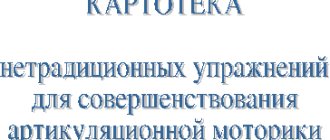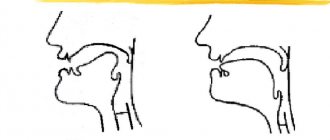Types and causes of violations of the pronunciation of the sound Ш
The distortion of sibilants is called sigmatism. In the case of the sound Ш, various options are possible:
- interdental - the tip of the tongue occupies a position between the upper and lower teeth, which gives a lisp;
- lateral - the tongue lies on its edge and a stream of air flows along its lateral edge. The result is a squelching sound;
- nasal - occurs due to the contact of the back with the soft palate, which, when lowered, opens a passage into the nasal cavity for an air stream;
- labiodental - the original sound is replaced by another unvoiced sound F. For example, cap - “fapka”.
Factors leading to articulation problems:
- physiological: short sublingual frenulum or high palate, malocclusion, tension or weakness of the lingual muscles;
- problems with phonemic and speech hearing, as well as insufficient development of memory, attention, and thinking;
- long-term use of the pacifier. This spoils the bite and leads to distortion of hissing sounds;
- repetition of incorrect pronunciation. For example, a child distorts his speech following adults or younger brothers/sisters.
You can diagnose the problem yourself, but it is better to contact a speech therapist in time.
Complex treatment of the disease
Only an integrated approach gives good results. Here are the activities included in treatment:
- Speech therapy classes: development of fine motor skills of the hands, breathing, motor skills of the speech apparatus, voice (timbre, intonation, strength), training in correct sound pronunciation;
- Physiotherapeutic procedures: physical therapy, massage, acupressure, etc.;
- Drug treatment. Nootropic drugs are prescribed;
- Psychotherapy. This group includes sand therapy, play therapy, and isotherapy.
If parents notice speech impairments in time and seek help from doctors, the baby has every chance of getting rid of the disease. But provided that there are no pronounced lesions of the nervous system.
Diagnostics
It is important to assess how well all components of speech are formed. If there are deviations, speech therapists pay special attention to the appearance of the lips, the tone of the tongue, the state of the bite, the work of facial and articulatory muscles, and the force of exhalation. Standard diagnostic exercises in speech therapy:
- Please show emotions: joy, surprise, sadness.;
- Stretching the lips with a tube and fixing them in a certain position;
- Movements of the jaw in different directions, attempts to relax the tongue, make it wide/narrow;
- Blowing away a light object, playing the pipe;
- Pronunciation of phonemes separately, as well as in words and phrases;
- Compose a story from the given words and pictures.
Based on the results of the examination, suitable exercises are selected for performance. You can use the classic options, widely used in speech therapy.
We train to navigate in space
- “Whose traces?” . Pictures with traces of hands and feet are needed. The baby must determine which arm or leg is right and which is left.
- "Supermarket" . The parent asks the child to arrange the goods: “on the shelf”, “near the cash register”, “to the right of the cookies”, “under the counter”.
- Counting sticks. Can be replaced with matches. The parent makes some figure out of them, and the baby makes a similar one according to the image.
This complex can also be performed at home.
Articulation of the sound Ш
Correct pronunciation is possible if certain conditions are met. The lips take a “horn” position - slightly rounded and pushed forward. There is a space of about 1 mm between the upper and lower teeth. A wide tongue takes the shape of a “cup” (the sides are pressed against the teeth, and the tip is located behind the upper teeth, leaving a gap between the tongue and the palate).
If everything is correct, then the stream of exhaled air goes in the middle, they are wide and warm. The vocal cords are open, and a dull consonant sound is produced.
It is necessary to regularly perform staging exercises with a speech therapist or at home to achieve the desired result.
A set of breathing exercises
Includes 2 exercises. Parents can easily do them with their baby at home.
"Racing" . Place two cotton balls on the table. The parent blows on one balloon, the child on the other. The one who moves his ball the greatest distance wins.
"Magic Breath" . Insert pieces of cotton wool into the baby's nostrils. The main thing is not deep! Ask him to exhale and at the same time hold the cotton wool - it should not fall out.
Another version of breathing exercises is according to A.N. Strelnikova. The essence of gymnastics is to take a sharp breath through your nose every second and do the exercises at the same time. The inhalation is noisy and strong, and the exhalation is natural, imperceptible.
There are several rules: with each inhalation, lower your shoulders and close your nostrils tightly, as if someone is pressing on them.
Gymnastics should be a joy, so you need to do it until the first signs of fatigue. There is no need to force your child if he does not want to study.
Gymnastics is designed for adults, so the duration of the lesson and the number of approaches is best agreed upon with a speech therapist.
Articulation gymnastics
It is important to carry out the performance in stages - first it is important to create sufficient strength and duration of the output. Speech therapists practice various articulation activities to relax the tongue and practice lifting it. You need to go from simple to complex, increasing the load.
At the first stage of setting the sound Ш, easy but important tasks are given to prepare the muscles of the tongue: make the lips a tube, open the mouth wide for a few seconds, lick the upper lip with a wide, cup-shaped tongue, move the tongue across the palate, from the teeth to the throat.
More complex common exercises for setting Sh:
- "Wide tongue" Ask the child to smile and slightly open his mouth, show his relaxed tongue like a pancake, and then place his tongue on his lower lip. Ideally, you should hold the position for up to 5 seconds;
- “Hide the candy.” Let your baby make a “pancake” of his tongue on his lower lip. Give him a piece of marshmallow or marshmallow and ask him to hide the treat by gluing it to the roof of his mouth behind his upper teeth. The mouth should not open too wide, and the exercise should be done at a slow pace;
- "Fungus". Ask your young student to smile widely and show his teeth, then press his entire tongue to the roof of his mouth. While holding the position, you need to try to open your mouth as wide as possible. It is optimal to perform the task in front of a mirror - the child will see the resemblance of the tongue and frenulum to a mushroom;
- "Groove". This task is important because it teaches you how to form a tubercle on the tongue, which is necessary for setting the Sh. First, your student shows a wide tongue, placing it “pancake-like” on the lower lip and slightly opening his mouth. Then he presses the edge of the tongue in the same position to the side corners of the mouth, the tongue itself narrows a little - the same “groove” is formed;
- "Cup". The tip and lateral edges of the tongue are raised and held in this position. To enhance the effect, a speech therapist or parent can pour a little water into the “cup”.
To avoid difficulties in positioning the Sh during classes, make sure that the child does not rest his entire tongue on the palate.
Methods for preventing the disease
Due to the biological factors in the development of the disease, it is worth thinking about its prevention during pregnancy and childbirth. Difficult pregnancy, intrauterine infections, asphyxia, complicated childbirth, injuries in the first months of a newborn’s life - all this can cause speech disorders in the future.
We list the main methods of preventing the disease after the birth of the baby.
First, develop your reflexes. These include gaze fixation and object tracking, auditory concentration, motor activity, and the oral automatism reflex - all of them are very important in the development of the newborn.
Secondly, communicate with the baby. Tactile, visual, auditory sensations - all this is extremely important for its development. Smile at him, talk to him, carry him in your arms, stroke him.
Third, be always there. This is especially true for mom. After all, a newborn needs her closeness, the opportunity to touch her, see her, feel her, and receive a return hug.
Fourth, stimulate the sucking reflex. The more actively and longer the baby suckles at the breast, the better its muscles develop - they become stronger and more flexible.
Fifth, encourage the baby's attempts to communicate. Humming and babbling - this needs to be stimulated.
Sixth, develop fine motor skills. Speech is directly related to fine motor skills and the more dexterous the baby’s hands are, the better. Introduce him to different textures.
Seventh, speak to your baby in your native language. Speak clearly and competently. And encourage him to communicate. Even if he doesn't talk, still try to make him make sounds. If he wants something and shows it with gestures, provoke him to ask for it verbally.
Staging from other sounds
The method is suitable for children with normal pronunciation of other phonemes from which Sh can be put:
- Through S. We pronounce a long “s-s-s” or stretch out “s-a-a-a”, fix the resulting position of the tongue. While pronouncing, use a spatula or finger to lift the tip of your tongue higher and hold it behind your upper teeth so that it touches the alveoli. Ask the student to exhale while maintaining the tongue position and see how “sa” changes to “sha”;
- Through T. Slowly pronouncing the phoneme with the addition of an aspiration “t-t-t”. We gradually learn to lengthen the air stream and not touch the tubercles on the palate with the tongue;
- Through R. A rare method due to the fact that this phoneme is usually even more difficult for children than sibilants. We keep our mouth open and say a silent R. We stop the vibration with the handle of a teaspoon, resulting in a hissing sound. Each time we use the spoon less and less, thus teaching the child to keep his teeth together and pronounce Sh automatically.
Always start with articulatory gymnastics - the tongue must be prepared for complex work. Warm up - at least 5 minutes. The total duration of classes should not exceed 25 minutes, otherwise children quickly lose interest.
conclusions
Dysarthria is not just a failure to pronounce certain sounds. And you certainly shouldn’t expect a child with such a diagnosis to “talk” like the neighbors’ daughter. This speech disorder is much deeper and more complex, but it is not always a death sentence. The main thing is not to waste time.
This is why turning a blind eye to the problem is a huge mistake as parents. Of course, it is difficult to accept the fact that your child has some kind of impairment. But this must be done precisely for the benefit of the future of your baby. An untreated disease will bring many problems to an adult in social life - from communication to work.
If the disease is detected at an early stage of development, it can be cured. An integrated approach to therapy gives good results. Of course, if there are no gross disorders of the nervous system.
It is even better if it was possible to diagnose the disease when it has not yet made itself felt, that is, before the baby’s first attempts to speak. Such early corrective work will become effective prevention.
Consolidating pronunciation
The speech therapist not only plays the sound, but also automates it. For preschoolers, lessons are structured in an interesting playful way. Approximate plan for stage-by-stage production of Ш:
- We look for the letter in the picture and learn a poem about it.
- We pronounce the syllables sha, sho, shu, after mastering them - ash, ush, osh.
- We consolidate open and closed syllables in conjunction with other phonemes: what, staff, jester.
- We train the pronunciation of words with Ш in the middle and at the end.
- We pronounce short and then more complex sentences with Sh.
We gradually complicate the tasks, fully introducing Sh into free speech. If difficulties arise in the performance, you should not move on to the next stage - it is important to hone your skills consistently. Work everything to perfection - there is no hurry.
Gaming techniques
To make the lessons more interesting and entertaining, prepare pictures or toys with “hissing” animals (goose, snake) and objects (a flat tire, a balloon, a ball). Show the goose how it stretches its neck and hisses, as if it wants to pinch a child. The boy was playing with a balloon, and it got stuck on a branch. And here you can use “sound tracks” - draw the path of the snake, how it crawls and hisses. A car is driving down the road with a flat tire.
After the sound is established and the baby can pronounce it more or less independently, you can move on to consolidating it in syllables, words and sentences. And at the same time try to place other hissing words: Ж, Ш, Ш, differentiating them from each other and from the whistling ones. All these exercises develop phonemic awareness very well, and the exercises “find the place of a sound in a word” or “come up with a word for this sound” also involve sound-letter analysis and synthesis, which is a good preparation for school. Much more useful than forcing your baby to read.
This concludes writing this article. There will be others where I will continue to talk about fixing the sound Ш and distinguishing it from S. So subscribe to new articles to always stay up to date. Share your impressions on social networks, and also write about your experience in the comments on the blog. Best wishes!
Supporting measures
Often with dysarthria there is an increased or decreased tone of the speech organs. In order to cope with this problem, speech therapy massage is used.
It can be either manual or probe. The procedure consists of stroking and light pressure on different areas. This is often done at the beginning of each lesson. This makes the muscles susceptible to the effects.
Dysarthria is often accompanied by increased salivation. To reduce secretion, give jelly, chew biscuits and crackers. Before the lesson, the child is seated on a chair, asked to throw back his head and imitate chewing. The speech therapist can massage the points behind the ears and the junction of the jaws. This will reduce the work of the glands.
There are no uniform patterns when producing sounds. For each child, methods are selected individually.









